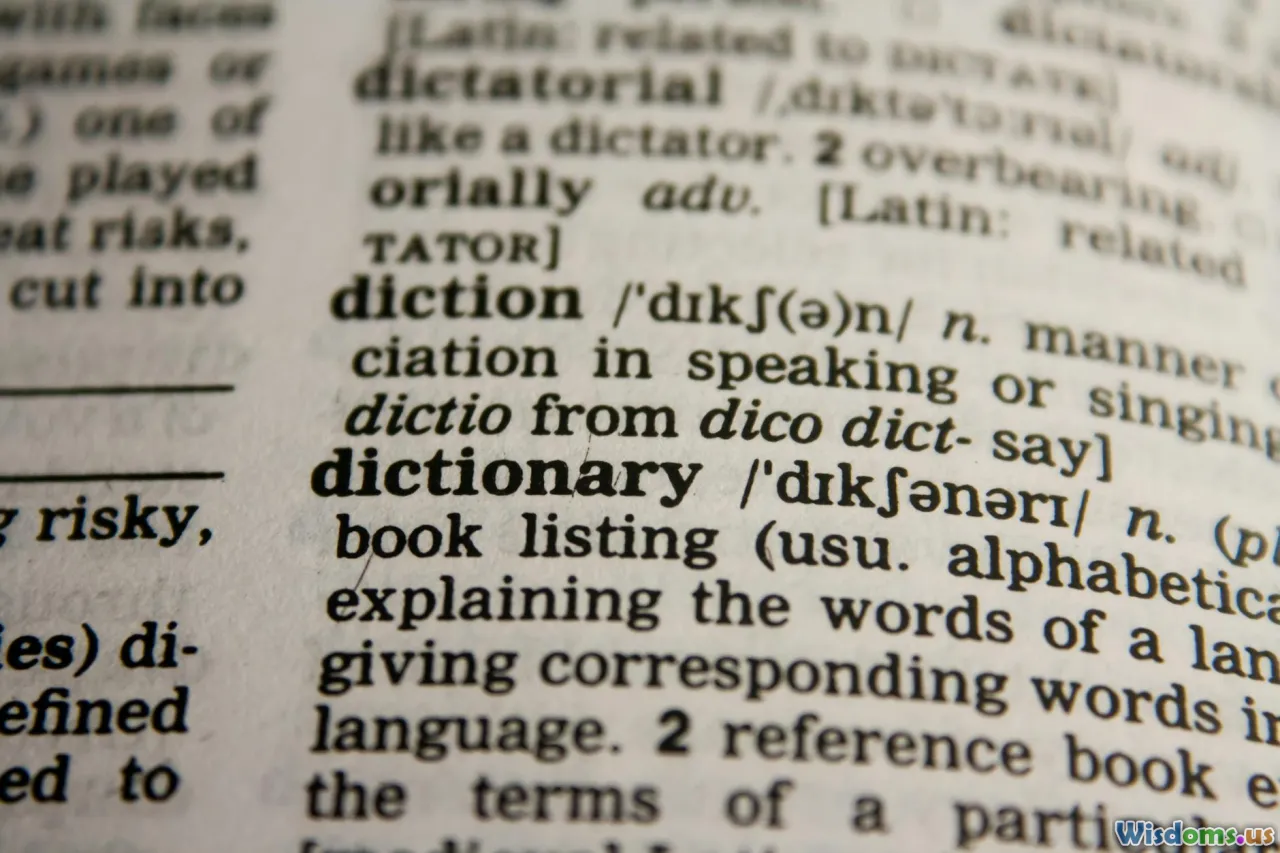
What Makes a Good Usage Example in Modern Lexicons
17 min read Explore the principles behind effective usage examples in modern dictionaries to enhance user understanding and language mastery. (0 Reviews)
What Makes a Good Usage Example in Modern Lexicons
The landscape of dictionaries and lexicons has evolved dramatically in the digital age. Users now demand examples that don't merely define but demonstrate language in context—making sense of nuances, tone, and usage. Above all, a well-crafted usage example is the bridge between the static entry and the dynamic realm of real-life communication. But what exactly separates a functional, modern usage example from the archaic, stilted quotations of old lexicons?
Let's explore the anatomy of excellent usage examples: why they matter, how they're made, and the tools lexicographers use to keep pace with changing linguistic realities.
Capturing Context: More Than Definitions

The primary function of a usage example is to show how a word operates in real contexts—not just its dictionary definition. Words live in sentences, and their full meanings can only be grasped in use. Consider the word "strike":
strike (noun): The factory workers began a strike after talks broke down.
This example does more than explain "strike" as a work stoppage. It gives a setting (factory workers), a cause (talks broke down), and a plausible outcome. It's not simply ordered words but a window into the word's habits—its collocates, its formality, even its typical subjects and objects.
Why Mere Definition Falls Short
Traditional quick definitions, no matter how concise, often fail to cover:
- Register (formal vs. informal)
- Emotional tone
- Grammatical patterns (prepositions, verb patterns)
- Cultural or regional senses
A robust usage example immerses the user in the natural environment of the word. For instance, the battered example "She gave me the book" lacks specificity. On the other hand:
He handed me the weathered book, its pages yellowed with age.
Not only is "book" in context, but it's evoking atmosphere and implicit interpretation—perhaps, sentimentality or the passage of time.
Authenticity Versus Artificiality

One major evolution in modern lexicography is the shift from fabricated to authentic examples. Early dictionaries featured sentences invented by editors, which risked sounding stilted or outdated. Modern computational tools allow editors to draw examples from contemporary corpora, novels, transcripts, and articles.
They 'ghosted' me after the first date.
Here, "ghosted" as modern slang demands real-world grounding. A fabricated example may miss nuances, but pulling a sentence from genuine internet forums or literature assures authenticity.
The Perils of Artificial Examples
Artificial examples tend to be:
- Overly generic (e.g., "He eats")
- Unrepresentative of current usage
- Lacking emotional cues or slang
Conversely, harvested authentic examples can carry socially relevant collocations, idioms, and emergent language patterns. Today, digital corpora—collections of texts from newspapers to tweets—make such real-life harvesting feasible and even routine for lexicographers.
Balancing Simplicity with Complexity

While authenticity is vital, the best usage examples balance clarity with richness. Overly complex sentences may confuse learners, especially those at earlier stages of language mastery. Contrast the following two usage examples for the verb "to mitigate":
We took steps to mitigate the risk.
vs.
After noticing the potential hazards associated with chemical spills in the laboratory environment, the technician immediately implemented strategies to mitigate ongoing risks and prevent accidents.
Both are accurate, both draw from authentic environments, but the first serves a wider range of learners. Editors must ask: does the sentence obscure the word's use, or spotlight it? Longer sentences may showcase subtle usage but risk overwhelming the user. Lexicographers often:
- Use a variety of sentence lengths across different entries
- Favor clarity in primary examples, with additional extended contexts in advanced resources
Simplicity does not mean childish—it means the word's function stands clear. When complexity is needed (to illustrate nuanced meaning or specialized contexts), it's flagged as such.
Representing Diverse Registers and Genres

English (and all living languages) spans formal and informal registers, technical jargons, and regional dialects. Good usage examples reflect this diversity. A dictionary's audience may include:
- Schoolchildren and language learners
- Academic researchers
- Casual web users
Consider "impact" as a verb—a phenomenon both common (business writing) and controversial (traditionalists prefer it as a noun). Usage examples may include:
- The policy changes will impact education funding across the district. (Business/government register)
- The meteor impacted near the river. (Scientific register)
This helps users grasp how register shapes meaning and appropriateness. Many modern online lexicons offer labeled sections ("informal," "archaic," "slang") to further guide learners. Corpora such as the British National Corpus or Corpus of Contemporary American English feed rich, contextual genre data into these examples.
Inclusivity and Social Sensitivity

Today's lexicographers are also tasked with ensuring that example sentences avoid reinforcing stereotypes, offensive language, or outdated social norms. For example, older entries might inadvertently caricature gender roles or ethnic groups ("The housewife cooks dinner"), whereas modern examples are more mindful:
Alex prepares dinner while Taylor puts the kids to bed.
This sentence demonstrates domestic activity without fixing roles by gender or traditional structure. Editorial guidelines across leading lexicons now require checks for social sensitivity, promoting language that is respectful, inclusive, and representative of society as it exists today.
Inclusive Language in Practice
- Gender-neutral names: "Jordan runs the meeting"
- Non-stereotypical professions: "The nurse examined the patient" (with varied gender names)
- Acknowledging contemporary family structures: "My parents picked me up after the game and took me to their apartment."
Such attention ensures language examples reflect genuine, varied social realities and avoid perpetuating hidden biases.
Leveraging Corpus Linguistics

The digital revolution enables editors to access vast fields of real-life language through corpora—collated bodies of text from myriad sources. Instead of relying on personal experience or literary quotation, editors can:
- Retrieve millions of language examples in seconds
- Search word frequency, collocation, register, region
For instance, crafting a usage example for "pivot" as a verb becomes straightforward:
After hearing customer feedback, the company decided to pivot and focus on a mobile-friendly platform.
This is a construction sourced directly from startup blogs and business reports, identified via corpus tools. Corpus linguistics ensures relevance and immediacy—capturing how language is actually used today. It also empowers lexicographers to:
- Spot emerging trends (e.g., "cancel culture", "doomscrolling")
- Identify problematic or dying usages
- Illustrate meanings with up-to-date syntactic constructions
Examples and Variants for Learners

Language learners face particular challenges in understanding idiomatic speech, phrasal verbs, or words with multiple senses. Good usage examples are tailored for their needs—often separated by sense, usage type, or region.
- Polysemy support: For "head" (noun):
- She bumped her head on the shelf.
- The head of the department announced the policy.
- Phrasal verbs: For "look up":
- (literal) She looked up at the stars.
- (figurative) He looked up the definition online.
Online dictionaries serving learners, such as Merriam-Webster Learner’s Dictionary or Cambridge Dictionary, often label their examples by level (A1, B2) or meaning, and accompany them with clear grammar pointers (e.g., whether the verb is transitive or intransitive).
Additionally, learner dictionaries might use slowed, graded language or chunked collocations to foster comprehension:
- The scientist conducted an experiment in the lab. ("conduct an experiment")
- She pays attention during class. ("pay attention")
Practical, reusable examples boost confidence and reinforce the patterns learners are most likely to encounter in real communication.
Keeping Pace with Semantic Change

Modern lexicons must update their examples regularly to reflect rapid shifts in language—semantic drift, new coinages, and cultural shifts. Consider how the word "viral" transformed from relating to viruses to describing content that spreads quickly online.
- Before: Measles is a viral infection.
- After: The video went viral on social media.
Lexicographical teams now routinely monitor news outlets, social media, and forums to capture the latest senses of a term, ensuring their examples reflect contemporary usage—a practice that also keeps reference works alive and relevant.
Case Study: "Binge"
Once linked almost exclusively to over-eating, “binge” now frequently appears in media and technology:
- He spent the weekend binge-watching his favorite series.
Such shifts pose challenges: when does a new sense demand a new example or entry? Lexicographers harness digital sources, analytics, and user queries to make these increasingly data-informed decisions.
Criteria for Crafting Outstanding Usage Examples

Lexicographers usually work from a set of tested guidelines. Outstanding usage examples typically:
- Provide vivid context: Frame the word within a familiar or easily imaginable setting.
- Fit the intended audience: Language, syntax, and themes should match the user’s age, proficiency, and interests.
- Show typical collocations: Illustrate how the word naturally connects with others.
- Avoid ambiguity: Make the specific meaning being illustrated transparent.
- Reflect society today: Avoid bias, stigma, or outdated stereotypes.
- Are concise but complete: Enough information to clarify, but not so much to overwhelm.
How-To: Writing Your Own Example
Suppose you’re writing a usage example for "negotiate" (verb, in a business sense):
Step 1: Identify the specific sense of meaning (to resolve differences)
Step 2: Choose a realistic setting (workplace, diplomatic meeting)
Step 3: Pick typical collocates (“terms,” “agreement,” “contract”)
Step 4: Write a natural sentence:
The two companies negotiated terms to finalize their partnership.
Revise for inclusivity, formality, and clarity. Consider an optional second example for a different context (e.g., "He negotiated his way through the crowded market.")
Technological Innovations: AI and Example Generation

Artificial intelligence and machine learning now assist in extracting, ranking, and refining usage examples from massive data pools. Programs analyze millions of real sentences, suggest samples, and even flag bias or errors.
- Automated extraction: Pulling relevant usage from newspaper archives or Reddit posts.
- Editing tools: Checking for grammar, register, and inclusivity.
- User feedback loops: Incorporating real-world queries and corrections from dictionary users.
These advances mean dictionaries can:
- Remain freshly updated
- Tailor content globally (British English, Indian English, African English)
- Reduce editorial load while maintaining quality standards
Machine-generated examples still require human review—ensuring clarity, tone, and cultural awareness. But the fusion of AI and lexicography is setting a new pace for innovation.
Improving Lexicons for a Global Audience

As English spreads worldwide, dictionaries and reference guides must capture the language’s global tapestry. Usage examples are now crafted—or curated—to represent International English, featuring names, places, and situations from Asia, Africa, Europe, and beyond.
Sita took the rickshaw to her office despite the rain. Mwangi texts his friend before breakfast every day.
Such examples showcase not only standard usage but a rich, pluralistic world. Overly Western-centric examples risk limiting the utility and relevance of a global lexicon. Top modern dictionaries seek balance: some entries highlight regional variants, bringing depth and inclusivity to every page.
The Enduring Art of Usage Examples

In the era of limitless access to language, well-crafted usage examples matter more than ever. They’re the scaffolding that upholds abstract definitions, the guide-ropes for learners and fluent speakers alike. From tracking language trends via corpora to leveraging AI, and promoting inclusivity and authenticity, the best examples never settle—they evolve in tandem with how communities speak, write, and connect.
The next time you look up a word and find a crystal-clear, inviting usage sentence, appreciate the art and insight behind it—it’s the silent partner to literacy, understanding, and effective global communication.
Rate the Post
User Reviews
Popular Posts














